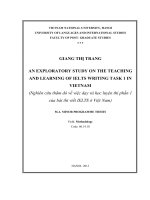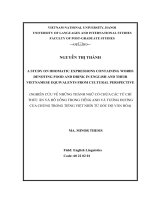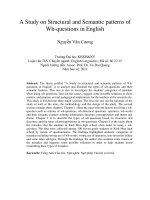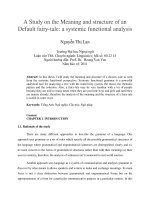A study on intonation as a means of conveying deontic modality in English
Bạn đang xem bản rút gọn của tài liệu. Xem và tải ngay bản đầy đủ của tài liệu tại đây (270.76 KB, 4 trang )
A study on intonation as a means of conveying
deontic modality in English
Nguyễn Thị Hồng Tuyên
Trường Đại học Ngoại ngữ
Luận văn Thạc sĩ ngành: English Linguistics; Mã số: 60 22 15
Người hướng dẫn: Assoc.Prof. Dr. Võ Đại Quang
Năm bảo vệ: 2010
Abstract. English intonation performs various functions and convey different meanings
in speech, especially modality. The study is aimed at: providing as exhaustive as possible a
description of the basic tunes in English and English deontic modality in terms of forms,
functions, features and meanings; giving systematic description of two semantic features:
obligation and permission as subtypes of deontic modality in English and studying the four basic
tunes in English as a means of conveying those two semantic features; finding mistakes
commonly made by Vietnamese learners in using Intonation as a means of conveying deontic
modality and offering some suggestions on possible solutions to these mistakes and implications
on teaching intonation as a means of conveying deontic modality.
Keywords. Ngữ điệu; Tiếng Anh; Biểu đạt tình thái
Content
1. Rationale:
In the process of learning English, a large number of learners recognize that intonation is
one of the most important issues and as the backbone of English. It not only causes difficulties
for the speaker himself but also for the listener. Since English intonation is considered as one of
the most important matter and as the backbone of English, there have been a lot of opinions
about this topic.
In J. P.O’ Connor’s opinion, the words themselves are unchangeable in expressing meaning but
they are enriched in the process of using tunes. What enriches the words is the speaker’s feelings
at that moment and this way of using tunes is called intonation. Here the phonetician wanted to
emphasize the important role of tunes in English because the speaker can use it to express his
state, he can say it definitely or hesitantly or sometimes he can say it with interest or without
interest.
According to Barbara Randford (1988), expressing oneself and understanding other
people are two of the most necessary goals for foreign language learners in general and for
English language learners in particular. In order to achieve two main goals successfully we must
know how to master English intonation effectively. It is the best way for us to express our
attitudes, feelings, emotion while we are speaking. On the other hand, it is helpful for us to
understand other people’s feelings, emotion in their specch so that we can lead our talks to the
result full of success and intelligibility. Furthermore, intonation helps us to focus on the most
considerable things to speak or express. This make our talks more interesting and we feel more
confident when we speak in public or in a crowd. With the wrong use of intonation, our speeches
may be broken because the listeners do not understand what are the goals of our speeches. More
seriously, in some cases they are not patient enough to pay attention to us and they may try to
find the way to stop our conversations as soon as possible.
In our everyday lives, much of our time is spent for communication with other people and
in our communication, we not only exchange facts but also express our emotions and attitudes,
or in other words we express modality.Thus, to study modality in general and investigate how
much a speaker commits to what he says in particular is very interesting and essential. Modality
gained much populaity among linguists. According to Halliday (1985: 86), modality is “an
expression of the speaker’s opinion” towards the content of what he is saying, whether he
considers it is possible, probable, certain, etc. For Lyon (1997), a speaker’s qualification of his
commitment to the truth of his/her proposition becomes an important issue. Besides, the study of
modality has spawned innumerable academic papers, namely Bybee (1985), Palmer (1986) and
others. In Vietnam, Hoµng Phª (1984) and §ç H÷u Ch©u (1989) have studied on Vietnamese
modal system and there have been a number of English-written M.A theses on this issue, for
example: Modality and Modal Auxiliaries: A systematic Comparision of English and Vietnamese
by §ç H÷- HuyÕn (1996); Modality in English by Hoµng Thu Giang (2001); A Contrastive
analysis of modal meanings expressed via Must, Should, Have to in English and the equivalent in
Vietnamese by Ph¹m ThÞ Mai Anh (2005).
Indeed, learning to express and interpret modality is very difficult, particularly for
learners of English as a foreign language. The learners’ failure in the understanding of the modal
meanings has already prevented the from getting the goals of communication. As a learner and a
teacher of English as a foreign language the writer has realized the importance of researching
intonation as a means of conveying modality, specificly on deontic modality to get the success in
communicating goals. It is the reason the writer would like to choose Intonation as a means of
conveying deontic modality in English as the subject for this thesis with the hopes that the
research can serve as a very small contribution to liguistic studies and also to teaching and
learning English as a foreign language. In addition, suggestions and pedagogical implications of
this study can be utilized to aid teachers of English and learners of Enlish at Hoa Lu University
in Ninh Binh province in the process of studying and learning English because in the school year
of 2009-2010, the first English majored students will be trained to become junior secondary
teachers of English for Ninh Binh Province.
2. Aims of the study:
The study is aimed at:
providing as exhaustive as possible a description of the basic tunes in English and
English deontic modality in terms of forms, functions, features and meanings.
giving systematic description of two semantic features: obligation and permission as
subtypes of deontic modality in English and studying the four basic tunes in English as a
means of conveying those two semantic features .
finding mistakes commonly made by Vietnamese learners in using Intonation as a means
of conveying deontic modality.
offering some suggestions on possible solutions to these mistakes and implications on
teaching intonation as a means of conveying deontic modality.
3. Scope of the study
It would be ideal for the thesis to study on intonation as a means of conveying both deontic
modality and epistemic modality. However, since the limitation of time , knowledge and the
aims of the study the writer focuses on Intonation as a means of conveying deontic modality,
more specificly, the four basic tunes in English as a means of conveying obligation and
permission in deontic modality.
4. Method of the study
In order to achieve the goal set from the beginning, a number of books and studies in the
field of intonation and modality were collected and then studied thoroughly to set up the
theoretical framework for the intonation and as well for the deontic modality.The study was
classified mainly based on the basic tunes in English by J.D.OConnor (1991) and by Assoc.
Prof. Dr Võ Đại Quang in Lecture on Principles of Phonetics and Phonology (2008), Nghiên
cứu một số ph-ơng tiện biểu đạt nghĩa tình thái trong câu - phát ngôn tiếng Anh và tiếng
Việt- (Thông Tin Khoa Học, Số 3-2008). About Modality, the study was mostly based on the
opinion of Palmer (1986).
And a combination of different methods of analysis will be used in this study:
The first is the discriptive method. Basic tunes in English and semantic features of
deontic modality will be described in turns to find out how intonation can convey deontic
modality.
Secondly, an investigation was made into the intonation and the deontic modality in
order to find out the commonest mistakes made by Vietnamese learners when studying
intonation as a means of conveying deontic modality by recording, interviewing, discussing with
the Vietnamese learners of English .
Finally, a thorough analysis on the results of the study was made to give the suggestions
and implications on teaching English intonation as a means of conveying deontic modality.
5. Design of the study
This study is designed in three parts:
Part 1 is the Introduction: this part includes the rationale, scope, aims, methodology
and design of the study.
Part 2 is the Development: This is the main part of the study and is divided into three
main Chapters.
Chapter One is dealt with the general theoretical concepts involving the subject under
consideration.
Chapter Two discusses the intonation as a means of conveying deontic modality in
English.
Chapter Three focuses on a number of mistakes existed on the process of studying
English intonation, especially conveying deontic modality.
Part 3 is the Conclusion: This part lays out the findings of the study, draws important
conclusions and suggests implications of teaching and learning English as a foreign language and
suggestions for further research are also presented.
References
English
1. Anh, Phạm Thị Mai., 2005, A contrastive analysis of modal meanings expressed via Must,
Should, Have to in English and the equivalents in Vietnamese, unpublished M.A thesis.
2. Anna Papafragou, 2000., Modality: Issues in the semantics-pragmatics interface,
ELSEVIER
3. Barbara Bradford, 1988., Intonation in Context, Student's book, Cambridge University
Press.
4. Bowlinger D., Crystal D., 1972, Intonation: Selected Readings, Penguin Books.
5. Brazil D., 1997, The Communicative Value of Intonation in English, Cambridge University
Press.
6. Brazil D., 2000, Pronunciation for Advanced Learners of English, Cambridge University
Press.
7. Bybee J., 1885, Morphology: A study of the Relation between Meaning and Form,
Amsterdam: Benjamin.
8. Downing Angela and Philip Locke., 1995., A University Course in English Grammar,
Phoenix ELT.
9. Frawley, William., 1992, Linguistic Semantics, Oxford: Lawrence Erlbaum Associates
Publishers.
10. George Yule., 2006, Oxford Practice Grammar, Oxford University Press.
11. Giang, Hoang Thu., 2001, Modality in English, unpublished M.A thesis.
12. Halliday, M.A.K., 1985, An Introduction to Functional Grammar, London: Edward
Arnold.
13. Harmer. J, 1999, The Practice of English Language Teaching, Longman
14. Hoa, Nguyen., 2000, An introduction to Semantic, VNU Publishing House.
15. Huyen, Do Huu., 1999. Modality and Modulation in English and in Vietnamese. A
systematic Comparison, unpublished M.A thesis.
16. Kenworthy J., 1997, Teaching English Pronunciation, Longman.
17. Kreidler C.W., 1989, The Pronunciation of English: A Course Book in Phonology,
Offord: Blackwell.
18. Kreidler C.W., 1998, Introducing English Semantics, Routledge.
19. Ladefoged P., 1982, A course in Phonetics, Harcourt Brace Jovanovich, New York and
London.
20. Leech.G., Semantics. Penguin Books.
21. Lyon, J., 1997, Semantic, Cambridge University Press.
22. O'Connor J.D., 1977, Better English Pronunciation, Cambridge University Press.
23. O'Connor J.D and Arnold G.F., 1983, Intonation of Colloquial English, Cambridge.
University Presss.
24. Oxford., 1992, Oxford Advanced Learner's Encyclopedic Dictionary, Oxford University
Press
25. Oxford. 1995. Oxford Advanced Learner's Dictionary, Oxford University Press.
26. Quang, Vo Dai, 2008, Lectures on principles of Phonetics & Phonology. Hanoi.
27. Quirk. R, Greenbaum.S, 1973., A University Grammar of English, Longman Group UK
Limited.
28. Quirk. R,et al, 1972, A Grammar of Contemporary English. London: Longman.
29. Palmer. F, 1986., Mood and modality, Cambridge University Press.
30. Palmer. F, 1986., Semantics. London: Longman.
31. Roach P., 1990, English Phonetics and Phonology: A practical Course, C.U.P.
32. Swan, Michael, 1986, Practical English Usage, Oxford University Press.
33. Tench P., 1996, The Intonation Systems of English, London: Cassell.
Vietnamese
1. Kỷ, Nguyễn Huy., 2006, Ngữ điệu tiếng Anh ở nguời Việt (English Intonation by the
Vietnamese), Hà Nội: NXB Văn Hóa Thông Tin.
2. Quang, Võ Đại., 2008, Nghiên cứu một số phương tiện biểu đạt tình thái trong câu – phát
ngôn tiếng Anh và Việt. Thông tin khoa học số 3- 2008 của trường ĐHNN_ĐHQG Hà Nội,
NXB ĐHQG Hà Nội.









